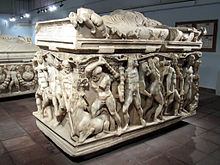Tiberiopolis
| Coordinates | 37°54′N 31°55′E / 37.900°N 31.917°E |
|---|---|
Tiberiopolis (Template:Lang-grc; sometimes in sources, Tiberiapolis, and Pappa-Tiberiopolis; formerly Pappa)[1][2] was a town in the Roman province of Phrygia Pacatiana, mentioned by Ptolemy,[3] Socrates of Constantinople[4] and Hierocles.[5] At various times, it was considered as part of Phrygia, Isauria, and the late Roman province of Pisidia.[6]
It struck its own coins at least from the time of Trajan.

It was situated at the modern village of Yunuslar, Beyşehir district, in Konya Province, Turkey.[2] At Tiberiopolis the famous Roman sarcophagus showing the Twelve Labours of Hercules now displayed at the Konya Archaeological Museum was recovered.[2]
It must have been Christianised at an early date. Nicephorus, a presbyter at Tiberiopolis was martyred in 361 or 362, and later cannonised.[7] His feast is celebrated on 28 November.[7]
Bishopric
Tiberiopolis
The bishopric of Tiberiopolis appears in the oldest Greek Notitiae episcopatuum among the suffragans of Laodicea in Phrygia, capital and metropolitan see of the late Roman province of Phrygia Pacatiana, but in the 8th century it was attached to Hierapolis in Phrygia, capital and metropolitan see of Phrygia Pacatiana Secunda, and as such appears in the Notitiae episcopatuum of the Ecumenical Patriarchate of Constantinople until the 13th century, when the area was overrun by the Seljuk Turks.
Bishops
Le Quien[8] mentions five of its bishops known by their presence at councils:
- Eustathius at a synod in Constantinople (536);
- Silas at the Second Council of Constantinople (553);
- Anastasius at the Quinisext Council (692);
- Michael at the Second Council of Nicaea (787);
- Theoctistus at the Fourth Council of Constantinople (879).
Roman Catholic titular see
Tiberiopolis remains a titular see in the Roman Catholic Church.[9] Titular bishops have been:[9]
- Thomas Williams, O.P. (1725–1740), Vicar Apostolic of the Northern District
- John MacDonald (1761–1779), Vicar Apostolic of the Highland District
- Istvan Gosztonyi (1815–1817)
- Pablo García Abella, C.O. (1827–1833), Bishop of Calahorra y La Calzada
- Gabriele Maria de Marchis (1834–1858)
- Michael Flannery (1858–1859), Bishop of Killaloe
- Pedro José Tordoya Montoya (1860–1875). Bishop of Cusco
- Eusebio Marie Semprini, O.F.M. (1876–1893)
- Mariano Antonio Espinosa (1893–1898), Archbishop of Buenos Aires
- Antonio Scotti (1898–1919)
- Adalbero Joseph (Michael) Fleischer, C.M.M. (1922–1963)
- Adolfo Rodríguez Herrera (1963–1964), Archbishop of Camagüey
Pappa
Under the name of Pappa, the town was also a bishopric of the province of Pisidia, and later a titular see of the Roman Catholic Church.[10]
Notes
- ^ Richard Talbert, Barrington Atlas of the Greek and Roman World, (ISBN 0-691-03169-X), Map 65.
- ^ a b c "Archived copy" (PDF). Archived from the original (PDF) on 2017-05-10. Retrieved 2017-06-11.
{{cite web}}: CS1 maint: archived copy as title (link) - ^ V, 2, 25.
- ^ Hist. eccl., VII, 46.
- ^ Synecdemus, 668, 9.
- ^ Lund University. Digital Atlas of the Roman Empire.
- ^ a b "St. Nicephorus, Presbyter, at Tiberiopolis - Catholic Online". www.catholic.org. Retrieved 2016-08-14.
- ^ Oriens christianus, I, 797.
- ^ a b Catholic Hierarchy
- ^ Catholic Hierarchy
References
- Attribution
 This article incorporates text from a publication now in the public domain: Herbermann, Charles, ed. (1913). "Tiberiopolis". Catholic Encyclopedia. New York: Robert Appleton Company. The entry cites:
This article incorporates text from a publication now in the public domain: Herbermann, Charles, ed. (1913). "Tiberiopolis". Catholic Encyclopedia. New York: Robert Appleton Company. The entry cites:
- William Smith, Dictionary of Greek and Roman Geography, s.v.;
- William Mitchell Ramsay, Asia Minor (London, 1890), 147, 458.
- Ancient Greek cities in Anatolia
- Catholic titular sees in Asia
- Defunct dioceses of the Ecumenical Patriarchate of Constantinople
- Roman towns and cities in Turkey
- History of Konya Province
- Populated places in Phrygia
- Populated places in ancient Isauria
- Populated places in Pisidia
- Populated places of the Byzantine Empire

